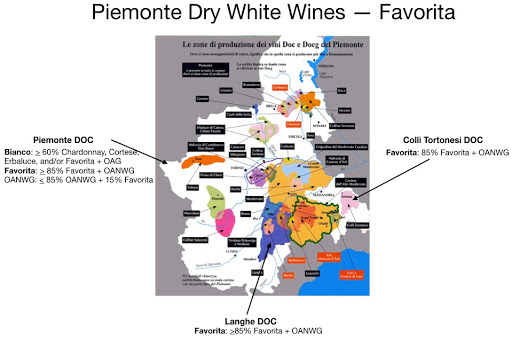My recent experiences with Piemonte dry whites have piqued my curiosity to the extent that I will be exploring the category in greater detail. I explore Favorita-based wines in this post.
Favorita has been shown to be the exact same variety as Vermentino, which is, itself, primarily grown in Sardegna (68%) and Tuscany (14%). Fully 80% of known Favorita plantings are found in Piemonte. The main characteristics of the variety are shown in the chart below.
Favorita wines are made in Piemonte according to the requirements shown in the following chart.
It should be noted that, in addition to Favorita, Colli Tortonesi DOC hosts high-quality white wines from the Timorassa and Cortese varieties.
I secured a bottle of the 2015 Langhe Favorita from Malvirà in order to evaluate this instance of Piemontese white.
Malvirà, located in Canale in Roero, was established in the 1950s by Giuseppe Damante. He subsequently passed the business over to his sons Roberto and Massimo in 1974. The sons transformed the business from a primarily bulk-wine supplier to one focused on quality. Today they plant 42 ha across six cru vineyards. The vineyards are farmed organically with all of the wines being sourced from estate fruit.
The Malvirà Favorita is sourced from three Canale vineyards: Saglieto (south to southeast exposure at 200 m elevation), Trinita (southwest exposure), and Bossola. The soils in these vineyards are calcareous clay and sand and the vines are between 30 and 40 years of age. Yields are at 50 hl/ha.
The wine is made from 100% Favorita grapes. The grapes are fermented in stainless steel tanks for 7 10 days and then aged in tanks for 4 - 8 months.
Floral, initially, with green herbs accompanying rich, intense fruit notes and spice. Full, round fruit intensity on the palate. Bright. Ripe lime with a slate minerality that gives way to a chalky minerality. Persistence of acidity through all phases. Excites the salivary glands in a low-key fashion. Loooong finish.
After a respite, I went back to the wine. I was now getting sweet white fruit, limestone minerality, salinity, and red pepper. On the palate, sweet fruit along with acidity and salinity. Great weight and lengthy finish.
This wine continues the string of excitement on which I have been tugging in this exploration of Piemonte dry whites. I loved it.
In terms of pairings, the literature sees this class of wine as perfect as an aperitif or as an accompaniment to fish, a typical Piemonte starter, or Risotto. I can't wait to try examples from the other identified regions.



No comments:
Post a Comment